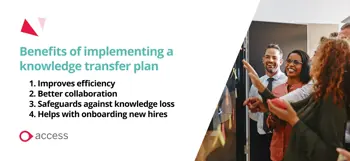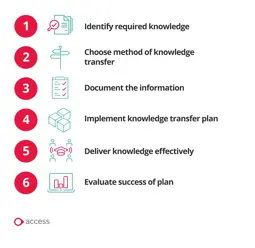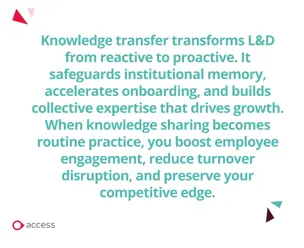Protect your business know-how: 6 steps for effective knowledge transfer
The urgency to retain critical knowledge has never been greater. One in four UK workers are planning to leave their jobs this year, and by 2030, nearly half of the UK workforce will be aged 50 or older. This combination of high turnover and an aging workforce means that many employees are either approaching retirement or actively considering career changes - putting businesses at risk of losing valuable expertise.
As roles evolve and skills become more fluid, the ability to capture and transfer institutional knowledge is essential to building a future-ready workforce. Fortunately, this risk can be managed with a structured knowledge transfer process: one that not only preserves know-how but also supports agility, resilience, and long-term capability building.
In this article, we’ll explore the meaning of knowledge transfer, how to implement it successfully, and provide some examples to help bring the process to life.
What is knowledge transfer?
Knowledge transfer is the process of systematically sharing critical information, skills, and expertise within an organisation to minimise knowledge gaps and maintain continuity in operations. While it is often emphasised during offboarding to ensure a smooth transition, effective knowledge transfer should be an ongoing practice throughout an employee’s tenure.
Embedding knowledge sharing across the employee lifecycle (such as during onboarding, employee development and succession) strengthens individual capability and builds collective intelligence within teams, ensuring resilience and adaptability over time. It can occur between individuals, teams, or departments and is especially vital in remote or distributed work environments, where physical separation can hinder informal knowledge transfer.
Types of knowledge sharing include:
Explicit
Knowledge is factual and easy to document and share. It could include manuals, reports or instructional guides.
Implicit
The practical application of explicit knowledge, often shared through informal practices. It can be learned by doing or observing others.
Tacit
Deeply personal knowledge rooted in individual experience, intuition, or insight - such as creative problem-solving or leadership instincts - that is difficult to express or transfer to others.
Beyond preserving these types of knowledge, having a knowledge transfer strategy plays a crucial role in driving innovation and adaptability. When knowledge flows freely, employees can build on existing insights, solve problems more effectively, and respond to change quickly and with greater agility. This collaborative learning environment not only enhances individual performance but also strengthens organisational resilience by reducing dependency on specific individuals.
Knowledge transfer methods
Below are four ways to share knowledge, skills, or expertise between individuals or groups within an organisation:
1. Mentoring
Mentoring involves one experienced person (mentor) guiding a less experienced individual (mentee), sharing critical knowledge, often through observation and feedback.
2. Documentation
This is the process of capturing key information in written or digital formats, preserving the knowledge and ensuring it is accessible and can be referred back to.
3. Workshops
Workshops are interactive group sessions which may involve presentations, discussions or hands-on activities. It can be used to teach specific skills or programs.
4. On-the-job training
This method of knowledge transfer involves employees learning by doing their day-to-day tasks. It is a hands-on approach which reinforces knowledge retention.
What are the benefits of knowledge transfer?
There is an array of knowledge transfer benefits that will enable your organisation to plan for the future. Let’s explore four in detail:
-
Improves efficiency
Knowledge transfer streamlines processes by ensuring critical information is readily available. When key information has been documented and stored correctly, it can be referred back to with ease, meaning no one is searching through folders to find the knowledge they are seeking.
-
Better collaboration
Sharing knowledge across teams encourages a culture of openness and trust, giving employees the confidence to ask questions, share information and benefit from a strong culture of knowledge sharing.
-
Safeguards against knowledge loss
Documenting key information protects organisations from disruptions caused by employee turnover. This ensures that knowledge and key details aren’t lost when an employee leaves the company.
-
Helps with onboarding new hires
When key information about skills needed for job roles is both documented clearly and easy to access, it makes the onboarding experience more streamlined. This helps train the new hire much faster and provides them with a better experience.

Why should knowledge transfer be part of your L&D strategy?
When employees move on or shift roles, they often take valuable institutional knowledge with them. That’s where Learning and Development (L&D) teams come in. By championing structured knowledge transfer, L&D professionals can safeguard organisational memory and ensure continuity. But knowledge transfer isn’t just about mitigating loss, it’s a proactive enabler of growth. Knowledge transfer streamlines onboarding, strengthens team capability, and fuels leadership development by embedding shared expertise into the DNA of the organisation.
Turning knowledge transfer into a regular practice means employees are more likely to take ownership of their development and support others in theirs, leading to improved engagement and retention. If an employee chooses to leave, formalising knowledge handover processes helps safeguard crucial information and ensures continuity, reducing disruption and preserving the organisation’s competitive edge.

How to facilitate knowledge transfer
Below are the six actionable steps you need to take to successfully facilitate knowledge transfer.
1. Identify the required knowledge
Determine which knowledge is critical to capture and share. This may involve speaking to an employee who is in the process of offboarding and finding out the information that needs to be retained, such as client information or essential skills.
2. Choose method of knowledge transfer
Select the most suitable method depending on the type of knowledge and the specific needs of the organisation. As discussed already, popular methods include mentoring, documentation or on the job training.
3. Document the information
Documentation is a crucial step in the knowledge transfer process. This could include video creation, step-by-step instructions or process maps for complex workflows. You may want to use tools such as a Learning Management System or collaboration platforms to help with this.
4. Implement knowledge transfer plan
Implement the knowledge transfer plan, ensuring the process is structured, interactive, and tailored to the needs of the learner. Utilise a knowledge transfer checklist which includes defined milestones, clear objectives and a suitable timeframe.
5. Deliver knowledge effectively
Once the knowledge is documented and the plan is in motion, you need to ensure it reaches the right employees in a structured and engaging way. Using an eLearning authoring tool can help tailor the knowledge and turn any dry information into interactive modules. You can then assign these modules through your LMS to individuals or groups based on their roles. An LMS with advanced features can even notify the learners that the specific modules are waiting for them.
6. Evaluate success of plan
To understand how successful the knowledge transfer process is, you must measure it. This could involve gathering feedback, performance metrics, or checking knowledge assessment. For a more interactive and enjoyable knowledge assessment experience, consider using a gamified learning platform or integrating mini quizzes into your LMS. These approaches leverage gameplay elements to reinforce learning and evaluate knowledge retention effectively.

Three examples of knowledge transfer
Let’s now discuss three examples of knowledge transfer so it is clear how the process can be actioned in practise.
1. Exit interviews with knowledge capture
When an experienced employee leaves, HR may wish to conduct a structured exit interview which focuses on documenting critical knowledge. This will ensure information is not lost after they leave. L&D should collaborate with HR to ensure the right level of detail is captured - enough to support upskilling of successors or team members, and to convert into learning resources. Consider documenting:
- Critical processes and workflows the employee took charge of.
- Key contacts and stakeholder relationships maintained.
- Lessons learned from past projects, including successes and challenges.
- Tips and shortcuts that aren’t currently stored.
L&D can then use this information to create reference materials, onboarding content, or structured training to support continuity and capability building.
2. Lunch and Learn sessions
A lunch and learn session can be an informal way to share knowledge. Organisations can host monthly sessions which showcase employees who present on topics they specialise in. Consider the following points:
- Rotate presenters monthly to involve different speakers.
- Encourage topics beyond work, such as productivity hacks, industry trends, or personal development.
- Record sessions and upload them to an internal learning content library or learning management system.
3. Mentorship training for succession planning
A senior project manager nearing retirement mentors a junior colleague over six months, ensuring the junior colleague can carry on the role successfully. Implementation tips:
- Define clear goals and milestones for mentorship period.
- Encourage reverse mentoring - junior staff can share fresh perspectives or tech skills.
- Document the mentorship journey in a shared log or journal.
Knowledge transfer best practices
To facilitate knowledge transfer successfully, consider following these best practices:
Encourage communication
Creating open and transparent communication channels is essential for effective knowledge transfer. When team members feel safe and supported in sharing their ideas, experiences, and questions, knowledge flows more freely. Encouraging feedback, recognising contributions, and promoting cross-functional collaboration can further strengthen communication, making it easier for knowledge to be exchanged naturally and consistently.
Make it simple and accessible
For knowledge to be truly useful, it must first be captured in a clear, concise, and consistent format, using plain language, logical structure, and visual aids like diagrams or infographics to simplify complex ideas. Once captured, it should then be made easy to access and share. This means it is stored in a central, searchable location and delivered in engaging formats such as videos or interactive content.
Provide ongoing training
Knowledge transfer should be viewed as a continuous process rather than a singular event. Regular training sessions, workshops, and mentorship programs play a crucial role in reinforcing learning and keeping skills up to date. These initiatives not only help employees upskill with new tools, processes, knowledge and industry developments but also promote a culture of continuous learning and development, essential for employee job satisfaction and retention.

 AU & NZ
AU & NZ
 SG
SG
 MY
MY
 US
US
 IE
IE

